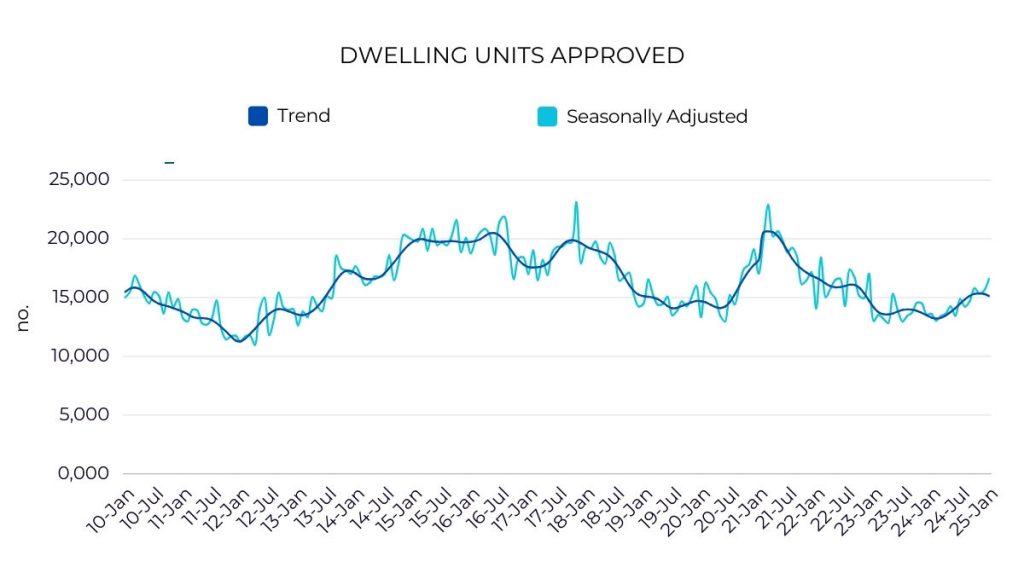Rateseeker Round-up: March Property News

As we reach the five-year mark since the COVID-19 pandemic first reshaped the world, Australia’s property and finance landscape continues to evolve, facing new challenges and offering fresh opportunities.
The past few years have been anything but predictable, from rising home values and shifting buyer behaviour to changing lending conditions. Yet despite economic headwinds and interest rate hikes, the market has shown remarkable resilience. Property prices have climbed significantly since 2020, rents are at record highs, and even as borrowing costs have risen, many Aussies have managed to adapt and stay on track with their financial goals.
This month, we are seeing early signs of change. Inflation is easing, sparking conversations about the potential for rate cuts. Home loan borrowers are reviewing their options as lender competitiveness increases, while building approvals are picking up, offering some hope for improved housing supply. Meanwhile, essential workers may have access to special lending benefits, and businesses across the country are holding steady despite pressure on margins.
In this article, we cover the latest market movements and what they could mean for you, whether you are buying your first home, investing, refinancing, or building.
Let’s start by taking a step back and looking at just how much the property market has transformed since March 2020. The numbers might surprise you.
Why Reviewing Your Home Loan Matters More Than You Think
When it comes to home loans, even a small difference in interest rates can add to big savings over time. In early March, the comparison website Finder found that the average and lowest available variable rate gap was 1.57 percentage points. For fixed rates, the gap was slightly smaller at 1.37 percentage points.
That might not sound like much on the surface, but over the life of a mortgage, it can make a significant impact.
Of course, not all home loans are created equal. The lowest rate is not always the best option for every borrower. Things like offset accounts, redraw facilities, or specific eligibility criteria can make one loan more suitable than another, depending on your financial goals and lifestyle.
Still, these figures are a timely reminder of just how important it is to review your home loan every few years. A lender that offered a great deal three or four years ago might not be as competitive today, and if you have not checked in for a while, you could be missing out.
To put it into perspective, here is what a borrower could save simply by refinancing from a loan with a 6.50% interest rate to one with 6.00%, assuming they have 25 years remaining on their mortgage:
- Around $46,359 in savings on a $500,000 loan
- About $69,538 on a $750,000 loan
- A potential $92,717 if you owe $1M
That money could go toward renovations, investments, or reducing your loan faster.
Ready to see if you could get a better home loan deal? Get in touch with Rateseeker today and let us do the legwork for you.
Homebuilding Approvals Rise, But Experts Say More Is Needed
There is positive news in homebuilding. Residential building approvals are increasing, indicating a potential rise in construction activity in the coming months.
According to the Australian Bureau of Statistics, 16,579 dwellings were approved in January 2025, a 6.3% increase compared to December and a 21.7% jump from the same time last year. It is also the highest monthly figure recorded since December 2022.

Economists are cautiously optimistic. Maurice Tapang from the Housing Industry Association called the results a positive sign as more households reenter the market.
New housing approvals had been strengthening on the back of low levels of unemployment, recovering real wages and ongoing strong population growth, even before the first interest rate cut was delivered in February.
Shane Garrett – Master Builders Australia chief economist
These increases in approvals signal positive momentum heading into the new year, he said. New housing approvals had been strengthening on the back of low levels of unemployment, recovering real wages and ongoing strong population growth, even before the first interest rate cut was delivered in February.
Still, not everyone is convinced that the current growth is enough to meet Australia’s long-term housing needs.
Shane Garrett, chief economist at Master Builders Australia, welcomed the uptick but pointed out that higher density development continues to lag. He said that higher-density home building has been at woeful levels for nearly a decade. Without a stronger supply in this part of the market, rental prices will continue to climb.
So while the recent surge in approvals is encouraging, industry leaders agree: we need to see this momentum build further, especially in apartments and medium-density housing, to tackle the broader affordability challenge.
Special Home Loan Benefits for Community Heroes
If you work in a frontline or community-serving profession, such as teaching, nursing, emergency response, or public safety, there may be a valuable opportunity waiting for you when it comes to buying a home. Some lenders are now offering lender’s mortgage insurance (LMI) waivers to eligible essential workers, which could save you thousands on your home loan.
LMI is an insurance premium most buyers need to pay if their deposit is less than 20% of the property’s value. For example, if you are buying a $600,000 property with a 10% deposit, you would usually be looking at an LMI cost of around $13,000. That is a significant upfront expense, especially for those trying to enter the market for the first time or purchasing on a single income.
However, some lenders are making it easier for essential workers by waiving LMI requirements, even if your deposit is below 20%. This can be a game changer, allowing you to get into a home sooner or spend your savings on other important costs like moving, furnishing, or renovating.
It is worth noting that these waivers are not offered by every lender, and eligibility can vary. Some lenders may require a minimum income level, specific employment status such as permanent full-time, or particular professional registration. Most commonly eligible roles include teachers, nurses, midwives, paramedics, police officers, and firefighters, but each lender sets their own criteria.
This benefit is not limited to first home buyers, either. You might still qualify if you are upgrading, downsizing, or looking to invest and work in an eligible field.
That is where working with a broker makes a real difference. At Rateseeker, we understand the credit policies across a wide range of lenders. We can help determine whether you qualify for an LMI waiver and guide you through the loan options that suit your needs and goals.
Avoiding LMI could mean thousands saved, and might be the key to making your next move happen sooner than you thought.
Five Years On: How the Property Market Has Transformed Since 2020
It has been five years since the start of the COVID-19 pandemic, and Australia’s property market looks very different today than it did back in early 2020.
At the time, there were plenty of gloomy predictions. Some banks even warned of a potential crash in home values. But the market proved far more resilient than expected. According to CoreLogic, the national median property price dipped just 1.7% at the onset of the pandemic before rebounding strongly. By March 2025, the national median was 38.4% higher than in March 2020.
Interestingly, regional areas outperformed the capital cities over those five years. Prices in the combined regions rose by a staggering 56.3%, while the combined capitals posted a still impressive gain of 33.6%. The lifestyle shift that saw many Australians relocate to regional areas during lockdowns has left a lasting impact.
Rental prices have also surged over the same period. The national median rent in March 2025 was 37.6% higher than five years ago. Both houses and units experienced similar growth, 38.7% and 35.1%, respectively. This is a notable turnaround, especially for unit rents, which fell sharply in the early stages of the pandemic as international student numbers and inner city demand dried up.
The interest rate landscape has also shifted dramatically. Before the pandemic, the Reserve Bank of Australia’s cash rate was 0.75%. In response to the unfolding crisis, the RBA cut it twice in March 2020 to 0.25%, then again in November to a record low of 0.10%. Those ultra-low rates helped fuel a rapid upswing in borrowing and property prices.
But the cycle has since reversed. With inflation rising, the RBA began lifting rates in 2022. As of March 2025, the cash rate stands at 4.10%, a stark contrast to the emergency settings of a few years ago.
So what does all this mean? In short, the Australian property market has shown remarkable resilience and long-term growth despite short-term disruptions. Homeowners and investors who stayed the course through the uncertainty of 2020 are now seeing the benefits. That said, today’s higher interest rates and elevated property prices mean careful planning and expert advice are more important than ever for anyone looking to enter or reenter the market.
From rising property values to shifting interest rates and new lending opportunities, the market continues to move, and staying informed is key to making confident decisions.
Whether you’re exploring your first home, considering a refinance, planning a build, or simply wanting to understand how these changes affect you, we’re here to help.
Reach out to the team at Rateseeker for personalised guidance, up-to-date insights, and support tailored to your goals.
** General Advice Warning
The information provided on this website is general in nature only and it does not take into account your personal needs or circumstances into consideration. Before acting on any advice, you should consider whether the information is appropriate to your needs and where appropriate, seek professional advice in relation to legal, financial, taxation, mortgage or other advice.




